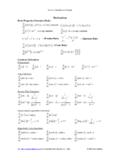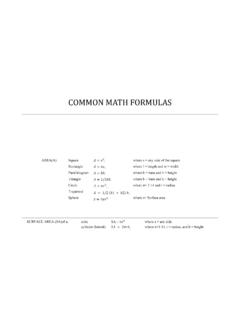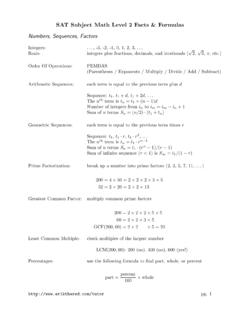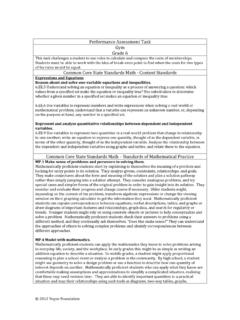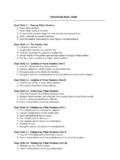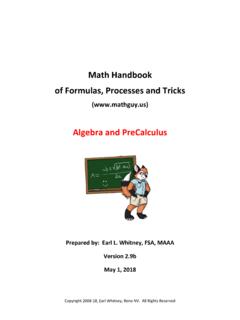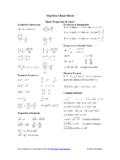Transcription of Geodesic Math - Salsburg
1 1 Geodesic MathAll Artwork, Graphics and Illustrations were created or made by:Jay Salsburg , Design Scientist, of an article by Joe ClintonGeodesic Math2 Geodesic MathProducing geodesics from the following article is an excerpt of an article by Joe Clinton on the different methods of producing geodesicsfrom the icosahedron. Formatted by Jay Salsburg , Design ScientistUsing analytical geometry (Fuller used spherical trigonometry), calculated on a computer:General procedure1. find the 3-dimensional coordinates of the vertices of the grid on the spherical surface2. find geometry using the different Methods3. calculate the chord lengths, angles etc. with these coordinates and analytical worked with Fuller on his programs and was funded by NASA on a project called Structural Design Con-cepts for Future Space Missions.
2 The specific motivation for developing these methods was to have a variety of forms to combine in large spaceframe domes. For example the Expo dome in Montreal is a combination of a:32-frequency regular triacon (Class II, method 3) and a16-frequency truncatable alternate (Class I, method 3)With known parameters and sophisticated analysis, large structures can be optimized by different combinationsand different methods; however, for small structures (up to 40') they are not generally relevant. What was called alternate breakdown, Joe classifies as Class I ; what was called triacon he classifies as Class II . Joewrote this section mainly with the intent of communicating the state of development of Geodesic geometries andthe hope that it would be an aid to those interested in exploring and expanding this MathDEFINITIONSA xial angle (omega ) = an angle formed by an element and a radius from the center of the polyhedron meet-ing in a common point.
3 The vertex of the axial angle is chosen as that point common to the polyhedron elementand axial angle may be found if the central angle is known by thefollowing equation: = 180 - 2 Central angle (delta , ) = an angle formed by two radii of the polyhedron passing through the end points ofan element of the polyhedron. The vertex of the central angle is chosen as that point common to both radii (thecenter of the polyhedron).Radiusaxial element(0, 0, 0)center of polyhedronvertex3 Geodesic MathThe central angle may be found by knowing the axial angles 1,& 2 at each end of an element. = 180 - ( + 12 )Chord factor (cf) = the element lengths calculated based on a radius ofa non-dimensional unit of one for the spherical form with the endpoints of the elements coincident with the surface of the the central angle is known, the chord factor may be calculated as follows:cf = 2 sin2 The length of any element for larger structures may be found by the equation:I = cf x rwhere: r = the radius of the desired structural formI = the length of the new elementDihedral angle (beta ) = an angle formed by two planes meeting in a common line.
4 The two planes them-selves are faces of the dihedral angle, and the element is the common line. To measure the dihedral angle mea-sure the angle whose vertex is on the element of the dihedral angle and whose sides are perpendicular to theelement and lie one in each face of the dihedral angle ( alpha ) = an angle formed by two elements meeting in a common point and lying in a plane thatis one of the faces of the Radius(0, 0, 0)2 1face of the dihedralface of the dihedralelement of dihedral4 Geodesic MathFace = any of the plane polygons making up the surface of the structural Geodesic MathPrinciple polyhedral triangle (PPT) = any one of the plane equilateral triangles which form the faces of theregular Geodesic MathPrinciple side (PS) = any one of the sides of the principle polyhedral Geodesic MathFrequency (Nu )
5 = the number of parts or segments into which a principle side is IClass IIOrientation = the orientation that the Polyhedral form has in space with respect to the observer are named:faceedgevertexMETHODS OF GENERATING 3-WAY Geodesic GRIDSUpon using the spherical form as a structural unit, it is apparent that the basic polyhedral form, in its fundamen-tal state, can not satisfy the range of conditions that must be geometrically and structurally met. There havebeen many methods developed for reducing the basic polyhedral form into a larger number of components fromwhich the geometrical properties may be made to remain within the structural fabrication and erection limits fora desired methods of generating 3-way Geodesic grids are discussed here in a broad sense to give the experi-menter a basis from which other methods may be 3 4 2 4 8 8 Geodesic MathThe methods described here may be considered as having characteristics of one of the two following classifica-tions:Class 1 or alternate - based on regular polyhedral forms, most generally the icosahedron.
6 - frequency of subdivision may be odd or = 10 + 2F = 20 E = 30 222 where:V = the number of verticesF = the number of facesE = the number of edges for total icosahedral sphere = frequency of subdivision -demonstrates symmetries as illustrated here:Class II or traicon-based on the quasi-regular polyhedral forms, most generally the rhombic of subdivision may only be = + 2F = 2 E = 3 ()()where: = 15 2V = the number of verticesF = the number of facesE = the number of edges for total rhombic triacontahedral sphere = frequency of subdivision2 - demonstrates symmetries as illustrated here:The green line is the edge of the icosahedron. The submerged red diamond object is the triacon face.
7 It isbeneath the surface in the graphic shown here because the edges are not coincident with the icosahedron faces,they are partially devised from the face centers of the icosa. This renders the triacon under the icosa to the symmetrical characteristics of the basic polyhedral form only one face, or portions of one face, of thepolyhedron is used for calculating the geometrical properties of the structural configuration. The remainingfaces may be found by rotations and/or reflections of this principle polyhedral triangle and its Geodesic MathCLASS IMethod 1 or alternate The PPT is subdivided into n frequency, with the parts chosen as equal divisions along the three principle point of subdivision is then connected with a line segment parallel to their respective sides thereby givinga 3-way grid so that a series of equilateral triangles are : AB is parallel to 12 ABCNote: A1 = 12 ABC is a plane equilateral12AB2110 Geodesic MathEach vertex on the PPT is then translated along a line passing through the origin (0, 0, 0) of the polyhedron andits respective vertex, onto the surface of the circumscribed sphere.
8 The element connecting the translated verti-ces form the chords of a 3-way great circular Geodesic MathMethod 2: (This method produces equal divisions along the spherical PPT and results in, for example, 3 differ-ent triangles in the 3 with 3 different strut lengths. Method I has 2 different triangles and 3 different struts)The PPT is subdivided into n frequency with the parts chosen as equal arc divisions of the central angles of : A1 12 The points of subdivision on each principle side of the PPT are connected with line segments parallel to theirrespective sides. Each line segment intersects at a number of points which define a grid of subdivision. Due tothe method of subdivision, small equilateral triangular windows occur in the : AB is parallel to 12Aa ab Windows are equilateral trianglesAabB21(0,0,0)AB1212 Geodesic MathThe centers of these windows are found on theplane of the PPT and are used as the vertices of the3-way grid for the PPT.
9 They are then translated ontothe surface of the circumscribed sphere along a linepassing through the respective vertex and the origin(0, 0, 0) of the polyhedron. The elements connectingthe translated vertices form the chords of a 3-waygreat circular 3:This method is sometimes referred to as the alternate Geodesic grid. Usually, it is developed by starting with asmall frequency and then subdividing further to the desired frequency by following a geometrical progression asper , the spherical polyhedral triangle is subdivided into a low frequency subdivision, 2 , with parts chosen as equal arc divisions of the central angle of the = 2 (0,0,0)RadiusIcosahedronedge(0, 0, 0)BA1 SphericalEdge13 Geodesic MathBy creating great circles at every icosahedral vertex, thismodel is deleting the great circles at every unneeded icosahedralvertex, this model is closer view of the icosahedral face of dividing the face using these markers, the Method 3geometry is developed.
10 NOTE : A1 = B1II14 Geodesic MathBy modeling a triangle on marks, 1, 2, and 3, further subdi-vision is created. This is noted by a, b, c, and d. NOTE :Aa = a13c = 1c1c AaIIIIII This symbol I that appears in the above equations represents the Icosahedral Great-Circle distance marked bythe points labeled in the accompanying interior points are found by passing great circle arcs through the previously found mid points of eachprinciple side and finding the mid points of each side of each new triangle in the same manner as point is then connected with great circle arcs to complete the 3-way further subdivisions each new triangle is subdivided as in the previous steps and connected to complete the3-way Geodesic Math16 Geodesic MathBy knowing the central angles ( ) the chord factors may be calculated by the following equation:cf = 2sin 2 where.

